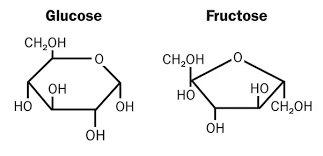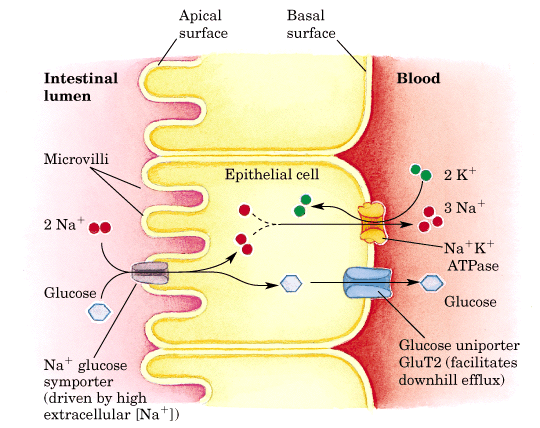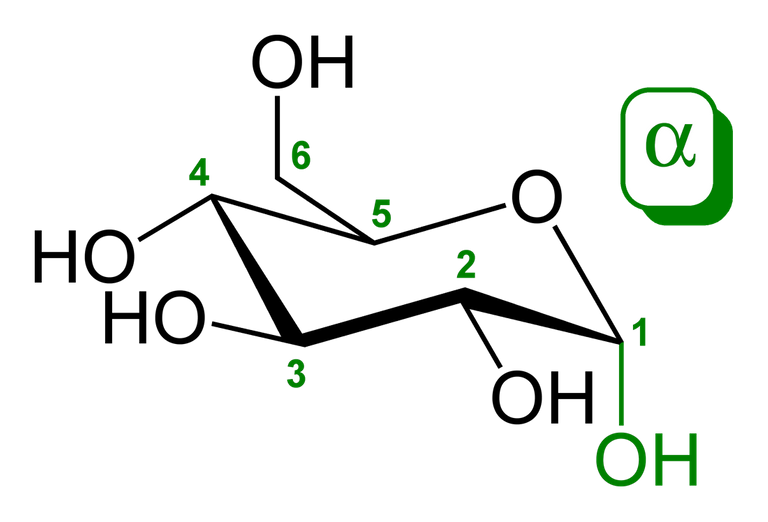
Introduction
Candy. Chocolate. Ice cream. Soda. These products are classic examples of food products that have a high sugar content. When something contains sugar what does that mean? Commonly, when people talk about sugar they are pointing at sucrose, also known as, table sugar. Sucrose is a disaccharide, consisting of the monosaccharides glucose and fructose (Figure 1). Sucrose, together with high-fructose corn syrup, is used in large amounts by the food industry to give a sweet taste to their products.


Figure 1. Left: molecular structure of sucrose. Right: molecular structure of glucose and fructose.I1,I2
In recent years, sugars have been getting more blame for the dietary issues people are having. Issues like obesity, fatty liver disease, cardiovascular disease, and type 2 diabetes. However, not all sugars are treated equally. A study from the Princeton Neuroscience Institute found that rats on a standard diet fed with extra water containing high-fructose corn-syrup gained much more weight than rats that were fed with water spiked with sucrose. Cardiovascular disease and type 2 diabetes can be caused by overweight itself. This overweight is usually a result of the extra intake of calories that high-sugar foods contain. Most of the other issues that sugars can cause are attributed to fructose.1,2 Since sucrose and high fructose corn syrup are the most added sugars, it’s good to start with looking at how their constituents are processed by the body.
Digestive pathways
Both for sucrose and high fructose corn syrup the ratio of fructose to glucose is about 55:45 in both products.1 Therefore, looking at how glucose and fructose are digested by the body will give substantial information on the results of the high consumption of sugar in current days. It is estimated that the average American ingests 10% of his/her daily calories as fructose.3,4 All this glucose and fructose, often in the form of sucrose, enter the stomach. The sucrose is broken down into glucose and fructose molecules so that they can be absorbed by the body. But glucose and fructose are treated differently by the body.
Glucose
Glucose is naturally occurring in plants and fruits, as it is formed during photosynthesis. Our bodies use a lot of glucose as fuel; it is often the main energy source for our brains.5
Although, some people like to feed their brain ketones. But that topic is better to discuss another day. Our bodies also like to store glucose as glycogen, which is a branched glucose polymer. The glycogen is stored in a hydrated form with the glycogen to water ratio as 3-4:1 (three to four parts water).6 This is where a lot of your water weight comes from, the backup energy has to be stored in water. For now, we’ll discuss the glucose that comes in through our mouth.
When glucose comes in through the stomach, finds it’s way through the duodenum into the small intestine (Figure 2).

Figure 2. Diagram of the lower gastrointestinal tract. After ingestion, the travel route for food is stomach, duodenum, jejunum, ileum, and colon. Leftover waste is discarded through the rectum and anus.I3
In the small intestine, it is readily absorbed into the bloodstream. This occurs by active transport with the help of the sodium ion (Na+) transporter (Figure 3). It is suggested that high concentrations of glucose can cause diffusive transport as well.7 Glucose is subsequently transported by the blood to the liver. However, your glucose intake doesn’t happen gradually with time. The liver is responsible for regulating the levels of glucose in our blood. It does this by storing glucose as glycogen reserves when insulin is released by the pancreas as a response to high blood sugar levels. When the blood sugar levels decrease the liver slowly releases glucose back into the circulation. Even when the glucose from carbohydrate sources has run out, the liver can produce glucose from non-carbohydrate sources in a process called gluconeogenesis. As I always like to say, our body loves homeostasis. It wants to keep everything at the same levels, and we see it here again with blood sugar levels.

Figure 3. Diagram of the glucose uptake through the epithelial cells of the intestinal wall.I4
The actual metabolism of glucose happens mostly on-site. Organs that need fuel use glucose and metabolize it using glycolysis. The complexity of the glycolysis warrants a separate post, but interested readers can already see the details here. The critical difference between glucose and fructose is the first step in the glycolysis. Glucose is first phosphorylated on the 6-position by hexokinase to make fructose 6-phosphate (Figure 4). It then undergoes a second phosphorylation, by phosphofructokinase on the 1-position, and from here it is cut into two three-carbon sugars. These are dihydroxyacetone phosphate (DHAP) and glyceraldehyde-3-phosphate (G3P) (Figure 5).8 One of these sugars converts to the other, and that other is used in the subsequent steps of the glycolysis phase.

Figure 4. Glucose molecule with numbered sites.I5
Fructose
Fructose has a very sweet taste. It is often called fruit sugar and, as you might’ve guessed, it occurs naturally in fruits. Besides as a part of sucrose, you can also find it naturally in honey. When fructose is metabolized, it goes through similar glycolysis steps as glucose to produce energy. Microbes actually process fructose exactly the same as they do glucose. Us mammals, we do it a little differently. Where glucose is first phosphorylated on the 6-position, and then by phosphofructokinase on the 1-position, fructose is phosphorylated on the 1-position immediately. This critical difference allows fructose to be cleaved after the first phosphorylation; it goes straight to DHAP and glyceraldehyde, which is G3P without the 3P. This means no phosphate group on the 3-position. The difference between glucose and fructose comes down to the use of phosphofructokinase. This critical enzyme is heavily regulated by the human boy, and therefore it’s action is the rate-limiting step in the glycolysis of glucose. So, fructose metabolism bypasses this step and moves much faster.1

Figure 5. First step of the glycolysis of glucose.I6
Effects of high fructose consumption.
Could the fast glycolysis of fructose contribute to the health issues that people with high fructose intake encounter? As you can see in figure 5 the first steps of the glycolysis cost energy; ATP is converted to ADP. Since the fructose bypasses the rate-limiting use of phosphofructokinase there is an energy drain. This is confirmed by AMP accumulation. This large concentration triggers AMP deaminase, which breaks AMP down to inosine monophosphate (IMP). This IMP is hydrolyzed to inosine, which finally produces uric acid. It was confirmed that ingestion of fructose causes AMP deaminase activity in cells of the liver.9 The effects of high fructose consumption, i.e. energy drain, AMP accumulation, uric acid formation, and glyceraldehyde formation, are getting more understood, however, the relation to the metabolic diseases and risks that follow are still a topic that is not well understood by science today.
Intermezzo: Adenosine triphosphate (ATP)
ATP is the energy unit of life. It is often referred to as the “molecular unit of currency” of intracellular energy transfer. The adenosine molecule has three phosphate groups bound to it. Releasing a phosphate group provides energy for all kinds of intracellular processes. It can release two phosphate groups, first from ATP to ADP (tri- to diphosphate), and secondly from ADP to AMP (di- to monophosphate).
Intestinal Shield
In order to better understand the effect of fructose on the human body researchers studied the digestion fructose. They labeled the fructose with a special marker and were able to track it through the body of mice. To their surprise, they observed that accumulation of the first phosphorylated fructose in the small intestine, which I mentioned was the first step of fructose glycolysis. This is curious because it was always assumed, judging from the fructose reaction products in the liver, that fructose glycolysis occurs in the liver. Remember: food goes from the stomach to the small intestine, where absorbed nutrients go from the portal vein to the liver. The researchers detected fructose and it’s metabolite products in the portal vein and found that for medium doses of fructose ~90% of the fructose is already converted to glucose and some organic acids. Higher doses of fructose showed that ~30% of fructose was already digested by the intestine. The remaining fructose goes to the liver, where it produces hepatotoxic compounds (hepato- = related to the liver), and some continuous onwards to the large intestine where our gut microbiome uses it as energy. The researchers expect that the fructose metabolism by the small intestine acts as a shield for the liver.1 If you want to learn more about our gut microbiome you can read my previous post.
How to overload the small intestine?
We can conclude a couple things from the research that has been done:
- Fructose processing by the liver produces hepatotoxic results and is a risk factor for fatty liver disease, diabetes type 2, kidney dysfunction, cardiovascular disease, and obesity.
- Fructose is initially, and preferentially, metabolized by the small intestine.
- Overload of the small intestine’s capacity to clear fructose caused fructose to be processed by the liver, with all ensuing consequences.
There is just one more thing to consider. What are these medium and high doses the authors mentioned? This medium dose is approximately 5 grams of sugar, equivalent to a quarter of an apple. A can of soda contains ~35 g of sugar, while an apple contains ~20 g of sugar. Both have quite a high sugar content, and therefore would be risk factors for the mentioned metabolic diseases. But an innocent apple surely wouldn’t be such a risk?
The authors also consider this. They point to the difference between gastric emptying of solid foods, like an apple, and juices/sodas that are liquid. The slower release of solid foods from the stomach makes the fructose release also slower, preventing intestinal overload of fructose clearance capacity. Juices and sodas don’t have this slower release.1
Conclusion
It is clear that the average person consumes much more sugar than the fructose shielding capacity of the small intestine can handle. Consuming these high amounts leads to fructose metabolism by the liver, which gives hepatotoxic results. In order to reduce the risk of fatty liver disease, diabetes type 2, kidney dysfunction, cardiovascular disease, and obesity, it is best to keep sugar intake limited. The stomach can aid the small intestine by reducing the delivery rate of sugar. This gastric emptying is slower when the stomach has to deal with more solid foods. Fiber-rich fruits and solid sweets, e.g. cake, would, therefore, be better options than soda or sugary juices. When you are consuming these high sugar beverages it is advised to consume them right after a meal, to take advantage of the slower gastric emptying caused by the meal. It takes very little sugar to damage your liver. It is quite unsettling when you realize many foods contain much more.
References:
- Jang et al. 2018
- Stanhope et al. 2015
- Bray et al. 2004
- Mariott et al. 2009
- Harvard Medical School - Neurobiology
- Kreitzman et al. 1992
- Kellett, 2001
- KhanAcademy - Glycolysis>
- Caliceti et al. 2017
Images (I#):
- Wikimedia
- Quora
- https://en.wikipedia.org/wiki/Gastrointestinal_tract
- Socratic – Saikat R.
- Wikipedia - Glucose
- OpenStax CollegeCC BY 3.0
Unsplash
Recently from @Altherion
Can gut microbes cause cancer?
Paper discussion #4 – The Cloning Revolution
Supplements #1: Echinacea
Paper discussion #3 - A prevention for cancer?
by FoodLabScience
Twitter

A scientist’s food for thought!

This is a test comment, notify @kryzsec on discord if there are any errors please.
Being A SteemStem Member
Not only that, but I was watching a TEDx talk recently, and apparently individual bodies react differently to different foods, regardless of the glucose.
Absolutely. You can make general guidelines for diets. However, when you go into specifics like carbohydrate/fat/protein fractions it is very much dependent on the individual. Include then the difference in gut microbiome between people and it becomes even more complicated.
While this talk is very interesting, I'm a little critical of their use of the glucose response as the end all be all parameter indicative of a healthy diet. I would have to look into their research to see their underpinning of why they think glucose response can be used in this matter.
I think it was probably just a matter of using some variable that was easy to control and test and get clear experimental results on. Given the presenter's whole philosophy on the matter, I think he'd agree that there's much more in play than just glucose response.
Sugar is very addicting and very hard to stay away from for us. We use mostly cane sugar in our homestead but are trying to move to the honey and maple syrup that we get from our permaculture farm.
Nice post thanks
followed
Very good! I also try to stay clear of cane sugar, but food producers manage to sneak it into many products. I'm always checking the labels to see what's in my food.